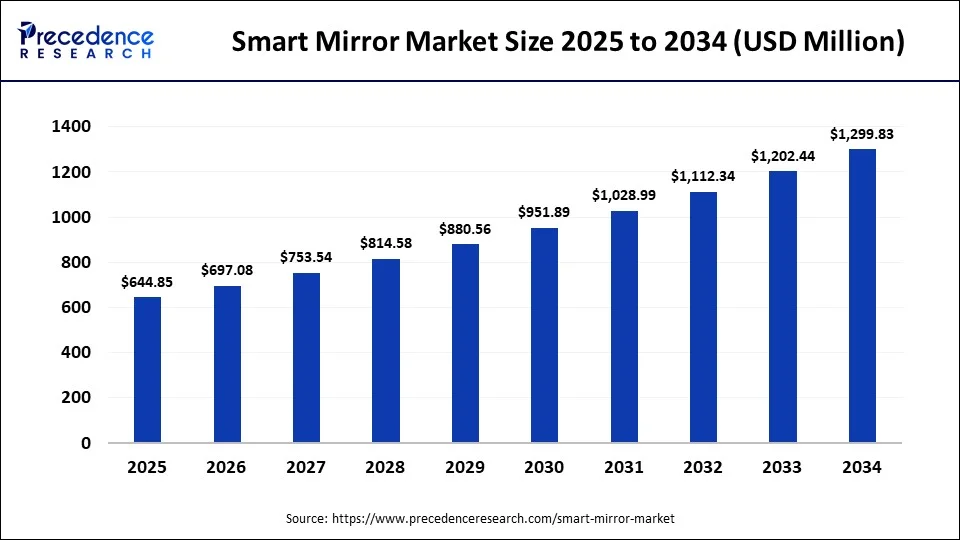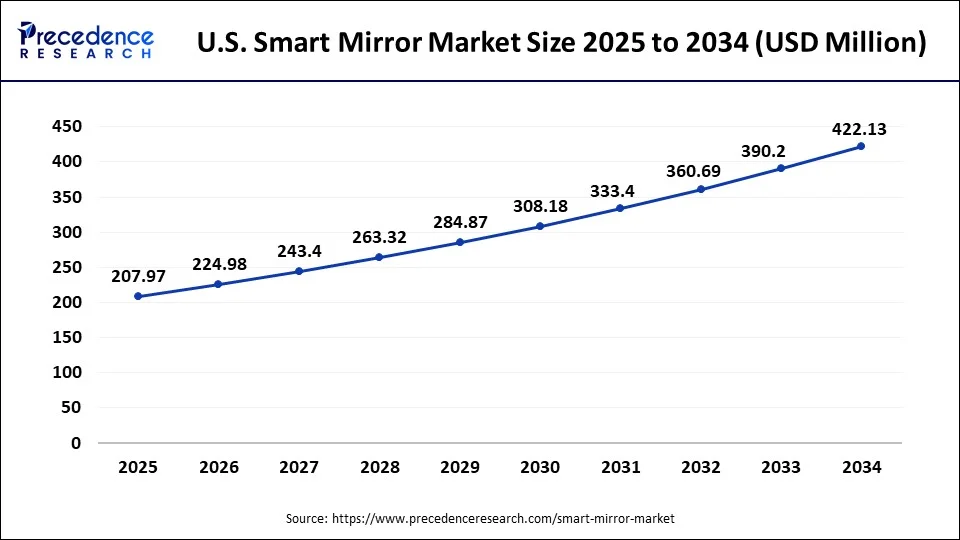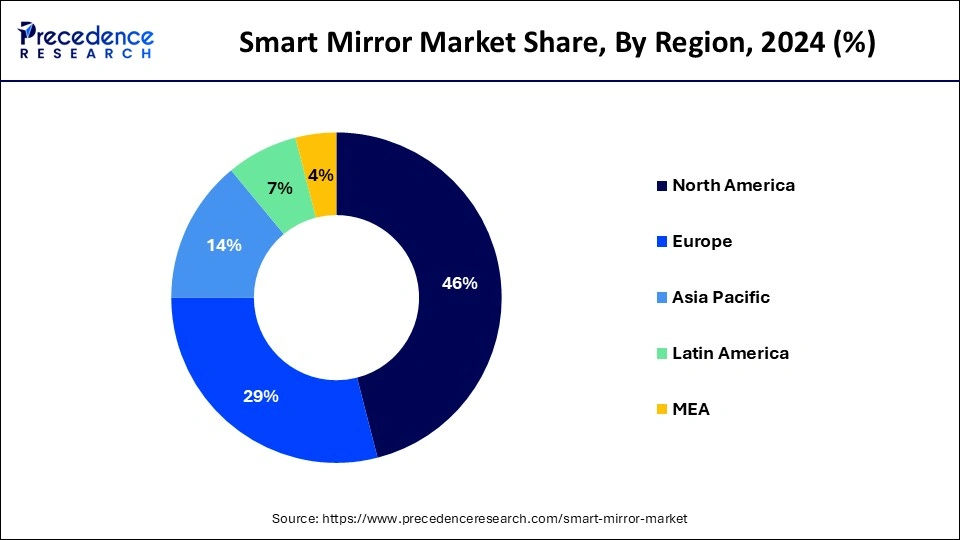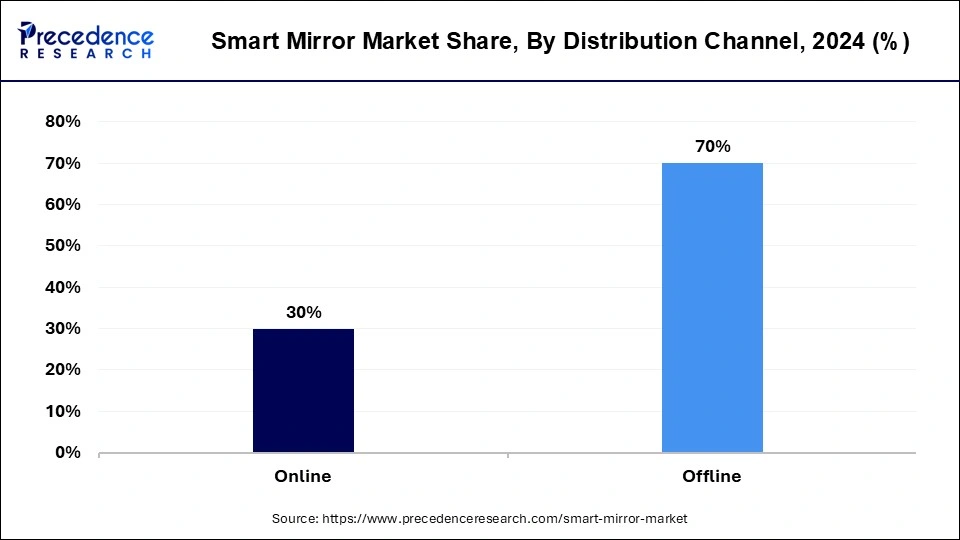January 2025
The global smart mirror market size was USD 551.83 million in 2023, calculated at USD 596.23 million in 2024 and is expected to be worth around USD 1,299.83 million by 2034. The market is slated to expand at 8.10% CAGR from 2024 to 2034.
The global smart mirror market size is worth around USD 596.23 million in 2024 and is anticipated to reach around USD 1,299.83 million by 2034, growing at a solid CAGR of 8.10% over the forecast period 2024 to 2034. The North America smart mirror market size reached USD 253.84 million in 2023. The smart mirror market is driven by increasing demand for fitness mirrors, smart homes, advancements in AI technology, integration of IoT in smart mirrors, and boosted security features like face recognition.

The U.S. smart mirror market size was exhibited at USD 177.69 million in 2023 and is projected to be worth around USD 422.13 million by 2034, poised to grow at a CAGR of 8.18% from 2024 to 2034.

North America dominated the global smart mirror market in 2023 due to high technological adoption, advanced infrastructure, and a strong consumer base. The region’s dominance is attributed to its early adoption of smart home technologies, significant investments in tech innovation, and robust retail sector using smart mirrors for enhanced customer experience.
HILO Smart Mirror, based in Montreal, Canada, is a North American company that focuses on the manufacture of interactive mirrors and uses augmented reality and artificial intelligence software to virtually try products and purchase processes directly on the mirror.

Asia Pacific is anticipated to proliferate at a significant rate in the smart mirror market over the forecast period. This growth is being driven by increasing urbanization, rapid technological advancements, the region’s expanding retail and real estate sector, and a growing emphasis on smart home solutions. These factors contribute to the rapid expansion of the market.
Smart mirrors have a built-in display that allows for interaction via voice commands. The smart mirror, while similar to other smart devices like smartphones, smart TVs, and smart lights, offers unique advantages due to its dual functionality as both a mirror and an interactive display. The smart mirror serves as both a personal assistant and an information center, displaying critical notices, the time, date, weather, and news at the same time.
The smart mirror market is driven by factors such as the rising demand for personalized and interactive home devices, advancements in AI and IoT technologies, increased focus on home automation, and the need for integrated security features. The primary motivation behind the smart mirror market is to improve quality of life. These factors contribute to the growing popularity and adoption of smart mirrors.
Impact of AI on the smart mirror market
A smart mirror is a simple mirror enhanced with technology to provide easy access to information services such as news feeds, weather updates, and time displays. It also integrates with AI features for real-time interaction with users. In the smart mirror market, the artificially intelligent smart mirror is designed to offer various functionalities and mimics a natural mirror interface using a flat LED monitor. This smart mirror, an embedded device with artificial intelligence, will include face recognition for authentication and security purposes, addressing the rising need to protect user attributes and profiles. AI arranges smart systems and creates interactive devices that improve user engagement.
| Report Coverage | Details |
| Market Size by 2034 | USD 1,299.83 Million |
| Market Size in 2024 | USD 596.53 Million |
| Market Growth Rate from 2024 to 2034 | CAGR of 8.10% |
| Largest Market | Asia Pacific |
| Base Year | 2023 |
| Forecast Period | 2024 to 2034 |
| Segments Covered | Installation Type, Application, Distribution Channel, and Regions |
| Regions Covered | North America, Europe, Asia-Pacific, Latin America and Middle East & Africa |
Increasing demand for smart homes
Smart home designs gradually focus on enhancing comfort, convenience, and security through information communication technology (ICT) to enable new user-friendly services. Smart mirrors offer a networked interface that allows users to manage and control electrical appliances, such as lamps and other home devices. By providing modified guidance on home management and device usage, these mirrors address the growing demand for user-friendly services. They significantly enhance functionality and aesthetics across various rooms, including dining areas, kitchens, and bedrooms. Beyond practical benefits, smart mirrors also offer entertainment options, contributing to a modern, connected lifestyle. This integration of technology into everyday objects reflects a commitment to meeting evolving customer needs and improving daily routines. Smart mirrors provide entertainment and contribute to a modern, connected lifestyle.
Increasing demand for fitness mirrors
The increasing demand for fitness mirrors knowingly contributes to the growth of the smart mirror market. Fitness mirrors, such as tonal, which combines interactive screens with advanced resistance technology, are becoming highly sought after for their ability to offer personalized workout experiences and real-time feedback. This trend reflects a broader consumer interest in integrating technology with fitness routines to enhance convenience and effectiveness. As more people seek interactive and AI-driven fitness solutions for home use, the market for smart mirrors is expanding, driven by innovations that merge physical exercise with digital guidance and evaluation. This growing demand highlights the potential for smart mirrors to evolve beyond traditional uses, tapping into the fitness and wellness sectors and fueling overall market growth.
High costs and limited application
The smart mirror market faces several restraints, primarily due to high costs and limited application scope. Currently, advanced smart mirrors, such as 3D and salon-specific models, are expensive, restricting their accessibility to public venues and niche markets. Additionally, these high prices and specialized applications limit their adoption among general consumers and hobbyists. The integration of advanced IoT technology and multimedia features, while innovative, contributes to the overall expense, further constraining market growth. Consequently, the high cost and narrow use cases of existing smart mirrors restrict broader consumer adoption and market expansion.
Samsung has produced a smart mirror, simply called Samsung Smart Mirror, which utilizes Intel’s RealSense technology. This technology is bleeding edge and is not easily procurable or affordable for this implementation.
IoT-enhanced smart mirror
The smart mirror market presents a significant opportunity by integrating IoT technology into everyday household items. The term Internet of Things (IoT) is associated with the connection of physical devices through the Internet. A smart mirror not only functions as a conventional mirror but also offers advanced features such as real-time weather updates and time and date displays. Additionally, it enhances home security by incorporating a camera behind the mirror that detects unknown faces and sends alerts to user’s mobile devices. This IoT-enabled device demonstrates the seamless integration of physical objects with the Internet, enabling remote monitoring and control. As IoT technology continues to evolve, smart mirrors are positioned to offer versatile applications for both home and commercial use, making them a compelling addition to the smart home market.
The wall-mounted smart mirror segment accounted for the largest share of the smart mirror market in 2023. These smart mirrors, mounted on walls, provide users with essential information such as weather updates, time, calendar events, news headlines, and more. They blend into bathroom or bedroom decoration while offering features like morning newsfeeds, exercise motivation, and appointment reminders. Essentially, a wall-mounted smart mirror displays relevant details such as time, date, weather forecast, and other useful information.
The free-standing smart mirror segment is expected to grow at a faster rate in the smart mirror market over the forecast period. There are a few different types, all of which can make an attractive and functional addition to your home as well as make your daily life easier. Growth is rapid due to its flexibility and versatility. A free-standing mirror is a mirror that is not attached to the wall or a vanity. Technological advancement enhances their functionality, and there is a growing consumer preference for interactive and adaptable technology. This flexibility and technological innovation position free-standing mirrors as a rapidly expanding segment in the market.
The commercial segment garnered the largest share of the smart mirror market in 2023. These smart mirrors are designed for commercial use and feature RFID access for employees. They display essential information such as weather updates, times, dates, calendar events, and daily schedules. They can also function as security systems. Smart mirrors, also known as magic mirror touch screens, offer a commercial-grade LCD with multi-touch technology, transforming the display into a mirror when not in use. These mirrors are used in industries such as automotive, housing, healthcare, retail, and others.
The residential segment is expected to show the fastest growth in the smart mirror market during the forecast period. By incorporating a smart mirror with a Raspberry Pi, the system proposes to offer centralized control, voice control, information display, and advanced lighting features to enhance the convenience and efficiency of managing a smart home. This project leverages Raspberry Pi’s capabilities to develop a smart mirror that serves as a central hub for managing various aspects of home automation. The mirror includes embedded motion and gas leakage sensors as a part of home security. This setup allows users to monitor their homes even when they are away, addressing common security concerns.
The online segment dominated the global smart mirror market in 2023. Smart mirror fashion technology (SMFT) permits customers to try on products virtually, improving their in-store experience. While customers may invest more time and effort in interacting with brands, they have less control over the engagement process compared to online environments. Offline channel advantages (OFA) provide consumers with richer experiences, including product interaction, social engagement, and the overall ambiance of the store. The goal of channel integration is to help consumers reduce transaction costs and maximize their experience benefits during the decision-making process.

The offline segment is anticipated to grow at the fastest rate in the smart mirror market over the forecast period. Online platforms offer comprehensive product-related information, including text, images, and videos, which helps customers make well-informed decisions. Consumers appreciate detailed, relevant product information and shopping experiences shared by others, and online channels are better equipped to meet these needs compared to offline channels. The ability to access rich, interactive content and user reviews online makes it a more attractive option for many shoppers, driving its rapid growth.
Segment Covered in the Report
By Installation Type
By Application
By Distribution Channel
By Geography
For inquiries regarding discounts, bulk purchases, or customization requests, please contact us at sales@precedenceresearch.com
No cookie-cutter, only authentic analysis – take the 1st step to become a Precedence Research client
January 2025
January 2025
October 2024
April 2024